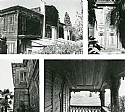Books
SÜREN MANSION
Beylerbeyi is the second pier along the Bosphorus coastline from Üsküdar. Its name is said to come from the Beylerbeyi [Governor] Mehmet Pasha of Sultan Murad III. The coastal road that extends from Beylerbeyi to Çengelköy is known as the “Yalıboyu Street.” Situated at the beginning of the Yalıboyu Street, which lies on the landward part of the road is a renovated old water reservoir. And the wide door right next to this water reservoir [41 Yalıboyu Street] provides access to the nearly 6,000-square meter area that hosts the XIXth-century building, which constitutes the subject of this booklet.
This block, which has a small yard on the road level, is comprised of a high wall and a series of terrace gardens on the hillside. The first terrace almost equals the size of the entrance garden. However, the second terrace above this is nearly 50 meters deep and hosts the building in question. Comprised of two full floors and an attic standing on a stone cellar, the mansion was probably commissioned by Dr. Colonel Fuat Bey in late XIXth century. We believe that the mansion must have been built on a section of the lands owned by the then Minister of Education Kocayusufpaşaoğlu Haşim Pasha. Later used by his daughter Talât Hanım and his son-in-law Prof. Nedim Mazhar Yüzak for some time, the structure was then put up for sale due to wear and tear in the 1970s. When Hatçe and Faruk Süren purchased it in 1992, the building was in a state of decay as a result of the modifications it had undergone over time and due to lack of maintenance.
The High Council of Immovable Monuments and Antiquities outlines the scale and depth of the alterations permitted on the cultural assets requiring conservation with its decision dated 14.1.1978 and no. 10200. Drafted by the Science Board of the Foundation for the Preservation of Turkey’s Monuments, Environment and Tourism Values [TAÇ], the decision undertook to resolve the complications created by the interventions in a series of structures on the Bosphorus Coastline, which had been grouped together by the High Council decision no. 5505 dated 11.09.1970. Over time, this resolution was degenerated and transformed into a classification for structures from an assessment of the scale and depth of the alterations permitted on the structures [High Council for the Conservation of Cultural and Natural Assets Resolution no. 660, dated 05.11.1999].
The characteristics of immovable cultural assets requiring conservation is not open to debate; it is either a cultural asset -and is registered as such- or not, which rules out the necessity of such a registration. However, certain recommendations are necessary as to how to modify such structures and how and by which methods to repair them. For particularly works of civic architecture are structures that are, and will be, inhabited. In parallel with the increasing need for comfort in daily life, expectations from large-scale structures also attain great heights. Certainly, a cultural asset requiring conservation cannot meet all modern expectations. Nevertheless, a prestigious venue may still be designed in a manner that reconciles the structure and its user. Indeed, this is one of the raison d’êtres of conservation councils. Members of such councils are responsible for reconciling user demands and the cultural asset in a manner that before all else preserves the qualities of the cultural asset with their knowledge, experience, and predisposition to a culture of reconciliation.
I made this explanation for the Süren Mansion, because it was a structure registered by the High Council of Immovable Monuments and Antiquities [GEEAY] as a cultural asset that requires conservation. However, it had lacked maintenance for a long period due to the financial difficulties experienced by its previous owners who also failed to find a buyer for the property. The structure was expected to collapse, or somehow, burn down. At that point, considering purchasing the building, the Süren family asked for my opinion as to what could be done with it. My response was, “We can do almost anything that would make you happy once you decide to carry this structure to the future. Just know that it will be a toilsome and exhausting job, and it may not be possible to do everything you want, but in the end, you will have a very prestigious place where you can live happily.”
Süren Mansion is the story of the reconstruction of a cultural asset that required conservation. The mansion was rebuilt using ferroconcrete, and certain smaller volumes that had been necessary in the past were removed to obtain larger rooms. The single-storey annex, which had been adjacent to the main entrance of the structure, was moved to a higher level, retaining its function. The separate entrances for men and women on the right and left faces of the mansion were preserved exactly while the corridors that connected these entrances to the vestibule were included in the rooms. The chaos created by previous modifications over time was resolved and the plan scheme became easily legible. Deteriorations on the external façades were repaired in an effort to restore their original look.














